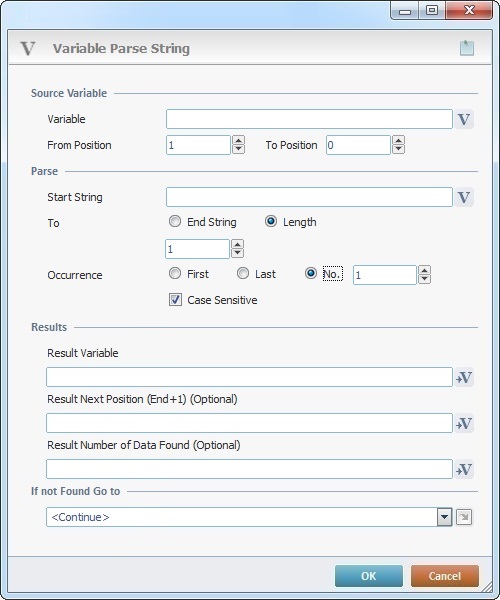Working with Variable Parse String Process
Process Purpose
The "Variable Parse String" process is used to parse data from a variable and store the result in another variable.
The parsing is done within a position range. It starts when the “Start string” is found and stops when the “End String” is found or when the specified number of characters is achieved.
The parsing process can search for a specific occurrence of the parsing condition.
The position of the first character, after the parsed data, can be saved in a variable for later use.
Check the provided "Variable Parse String" examples at the end of the topic.
When you add a process, you are required to define its settings. This occurs in the process's properties window which is displayed automatically after having added the "Variable Parse String" process.
If any subsequent edition is required, double-click the process to open its properties window and enter the necessary modifications.

Fill in the following options:
Source Variable |
|
Variable |
Click |
From Position |
Define the initial position for the parsing scope, meaning, the starting point to be considered for the parse condition. |
To Position |
Define the final position for the parsing scope, meaning, the end point to be considered for the parse condition. If you want the scope's final position to be the final character of the data string included in the source variable, maintain the default value "0". |
Parse |
|
Start String |
Define the initial character(s) of the string to be parsed. Either click |
To |
Use one of the following to define the final character(s) of the string to parse: Check "End String" and enter the intended character(s) into the corresponding box or click OR Check "Length" and insert the specific number in the resulting box. |
Occurrence |
Define an occurrence criterion by checking “First”, "Last” or “No” (in this last case, specify the number in the resulting option). |
Case Sensitive |
Check this option to force a lower/upper case comparison for the defined string parsing. |
Results |
|
Result Variable |
Click |
Result Next Position (End+1) (Optional) |
If required, click |
Result Number of Data Found (Optional) |
Click |
If not Found Go to |
|
Define a target location, in case any of the given elements for the parsing operation are not found. Either use a destination from the drop-down list or select one from the
|
|
Detail of a ![]() window:
window:

"S:Menu" is a screen included in the same program as the process.
"R:Routine_1" is a routine included in the same program as the process.
If required, click ![]() (on the upper right corner) and enter info on this process in the resulting text box. These notes will be displayed in the corresponding "Actions" tab or "Process" window (in the "Notes" field) and in the "Developer Report".
(on the upper right corner) and enter info on this process in the resulting text box. These notes will be displayed in the corresponding "Actions" tab or "Process" window (in the "Notes" field) and in the "Developer Report".
After filling in the required options, click ![]() to conclude or
to conclude or ![]() to abort the operation.
to abort the operation.
The added process is displayed in the corresponding "Actions" tab or "Process" window.
![]() If you want to use a label as a target destination, you can use the "Auto-Label" mechanism. This alternative to the "Set Label" process allows you to create a label in the properties window of a process - specifically, in the fields used to define target destinations (ex: the "If Error..." type fields). See To Automatically Create a Label.
If you want to use a label as a target destination, you can use the "Auto-Label" mechanism. This alternative to the "Set Label" process allows you to create a label in the properties window of a process - specifically, in the fields used to define target destinations (ex: the "If Error..." type fields). See To Automatically Create a Label.
![]()
Use the right-click in MCL-Designer's input boxes to access some related options as well as the general "Cut", "Copy"; "Paste"; "Search" actions (active/inactive according to the current context).
Ex: If you right-click the "Variable" input box (included in a "Conversion's" properties window), you are provided with general editing/search actions and other more specific options such as "Variable Select" (see "Variable Select"); "Variable Insert" (see "Variable Insert"); "Insert Special Character" (see To Insert Special Characters into a Control's Text Input Field) and "Localization Select" (see Localization List).
If you right-click another input box, it may provide other possibilities.

String included in the source variable: 12;AB;34;CD;56;12;AB;CD;12;58;12
|
||||||||||||||||||||||||||||||||||||||||||||||||||||||||||||||||||||||||||||||||||||||||||||||||||||||||||||||||||